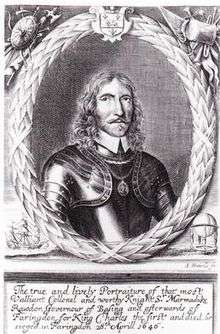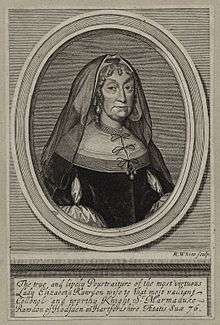Marmaduke Roydon
Sir Marmaduke Roydon (also Rawdon and Rawden, with Royden a contemporary spelling[1]) (1583 – 28 April 1646) was an English merchant-adventurer and colonial planter, known also as a Royalist army officer.

Life
The son of Ralph Roydon or Rawdon of Rawden Brandesby in Yorkshire, by Jane, daughter of John Brice of Stillington,[2] he was baptised at Brandesby on 20 March 1583. At sixteen years of age he went to London, where he was apprenticed to Daniel Hall, a Bordeaux merchant, who sent him as his factor to France. He returned to London about 1610 and was elected a common councilman. Soon afterwards he was presented with the freedom of the Clothworkers' Company, and made captain of the city militia.[3]
In 1614 Roydon joined a mercantile venture (with John Buley, George Langam and William Skelton)[4] to the New England coast, sending out two ships under Thomas Hunt and John Smith, which sailed from the Downs on 3 March 1614. He was also interested in the discovery of the North-West Passage.[3]
Roydon was one of the first planters in Barbados. With two others, he was granted 10,000 acres in Barbados, in April 1628, by James Hay, 1st Earl of Carlisle. This award set off a sharp struggle between Roydon's followers, and those supporting the claims of William Courten. In the end Carlisle's grant was upheld. Roydon, however, is said to have lost £10,000.[5]
Roydon also ventured to other parts of the West Indies and to Spain, Turkey, and the Canary Islands.[3]
In 1622 Roydon built Rawdon House in Hoddesdon.[6] The year 1626 saw him accused of belonging to a cartel trying to monopolise the wine trade of London. In 1628–9 he became M.P. for Aldeburgh.[7] In the First English Civil War he fought on the king's side, raised a regiment at his own cost, and took part in the defence of Basing House (1643). On 28 December of the same year he was knighted. In 1645 he was made governor of Faringdon in Berkshire, where he died on 28 April 1646.[3]
Family

In 1611, while a clothworker in All Hallows, Barking, he married Elizabeth, daughter of Thomas Thorowgood of Hoddesdon, Hertfordshire. Their son Thomas fought as a colonel in the Royalist army, and after the battle of Marston Moor went into exile in the Canaries. His nephew, the younger Marmaduke Rawdon, lived in his house for some years from 1626.[3] Martha Moulsworth the poet was Elizabeth's stepmother.[8] Her Memorandum of Martha Moulsworth Widdowe (1632) is believed to have passed in manuscript to Roydon and then his nephew.[9]
References
- Robert C. Evans, A Silent Woman Speaks: "The Memorandum of Martha Moulsworth, Widowe",The Yale University Library Gazette Vol. 69, No. 3/4 (April 1995), pp. 149–162. Published by: Yale University, acting through the Yale University Library. Stable URL: https://www.jstor.org/stable/40859118
Notes
- Ann Lady Fanshawe (30 May 2005). The Memoirs of Ann, Lady Fanshawe. Kessinger Publishing. p. 355. ISBN 978-1-4179-0627-7. Retrieved 29 March 2013.
- There are two places in England called Stillington. Stillington, North Yorkshire seems by far the more likely location - it is about 2 miles from Rawden Brandesby.
- Lee, Sidney, ed. (1897). . Dictionary of National Biography. 49. London: Smith, Elder & Co.
- Eric Jay Dolin (17 July 2008). Leviathan: The History of Whaling in America. W. W. Norton & Company. p. 18. ISBN 978-0-393-33157-8. Retrieved 29 March 2013.
- Richard B. Sheridan (1974). Sugar and Slavery: An Economic History of the British West Indies, 1623-1775. Canoe Press. p. 83. ISBN 978-976-8125-13-2. Retrieved 29 March 2013.
- "Hoddesdon, Urban and Rural". An inventory of the historical monuments in Hertfordshire. Institute of Historical Research. 1910. Retrieved 29 March 2013.
- historyofparliamentonline.org, Rawdon, Marmaduke (1582-1646), of Water Lane, London and Hoddesdon, Herts.
- Evans, Robert C. "Moulsworth, Martha". Oxford Dictionary of National Biography (online ed.). Oxford University Press. doi:10.1093/ref:odnb/47074. (Subscription or UK public library membership required.)
- Evans, pp. 152–3.
- Attribution
![]()